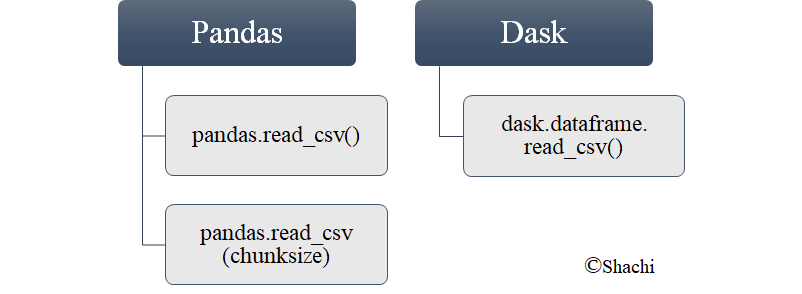Fast-csv Example to Read Csv From S3
Optimized ways to Read Large CSVs in Python
Hola! 🙋

In the current time, data plays a very important role in the analysis and building ML/AI model. Data can exist constitute in various formats of CSVs, flat files, JSON, etc which when in huge makes information technology difficult to read into the memory. This web log revolves around handling tabular data in CSV format which are comma divide files.
Problem: Importing (reading) a large CSV file leads Out of Memory mistake. Not enough RAM to read the entire CSV at once crashes the computer.
Here's some efficient ways of importing CSV in Python.

Now what? Well, let's ready a dataset that should be huge in size and so compare the performance(time) implementing the options shown in Figure1.
Let's start..🏃
Create a dataframe of 15 columns and 10 million rows with random numbers and strings. Export it to CSV format which comes around ~ane GB in size.
df = pd.DataFrame(information=np.random.randint(99999, 99999999, size=(10000000,14)),columns=['C1','C2','C3','C4','C5','C6','C7','C8','C9','C10','C11','C12','C13','C14']) df['C15'] = pd.util.testing.rands_array(5,10000000)
df.to_csv("huge_data.csv")
Let's look over the importing options now and compare the fourth dimension taken to read CSV into memory.
PANDAS
The pandas python library provides read_csv() function to import CSV as a dataframe structure to compute or clarify it hands. This function provides one parameter described in a later department to import your gigantic file much faster.
1. pandas.read_csv()
Input : Read CSV file
Output : pandas dataframe
pandas.read_csv() loads the whole CSV file at in one case in the memory in a single dataframe.
outset = fourth dimension.fourth dimension()
df = pd.read_csv('huge_data.csv')
end = time.fourth dimension()
print("Read csv without chunks: ",(stop-beginning),"sec") Read csv without chunks: 26.88872528076172 sec
This sometimes may crash your organization due to OOM (Out Of Memory) error if CSV size is more than your memory's size (RAM). The solution is improved by the side by side importing way.
2. pandas.read_csv(chunksize)
Input : Read CSV file
Output : pandas dataframe
Instead of reading the whole CSV at one time, chunks of CSV are read into retentivity. The size of a chunk is specified using chunksize parameter which refers to the number of lines. This office returns an iterator to iterate through these chunks and so wishfully processes them. Since only a role of a big file is read at once, depression retentiveness is enough to fit the data. Afterward, these chunks tin can be concatenated in a unmarried dataframe.
offset = time.time()
#read data in chunks of one 1000000 rows at a time
clamper = pd.read_csv('huge_data.csv',chunksize=1000000)
stop = time.fourth dimension()
print("Read csv with chunks: ",(end-commencement),"sec")
pd_df = pd.concat(chunk) Read csv with chunks: 0.013001203536987305 sec
This option is faster and is all-time to use when you have limited RAM. Alternatively, a new python library, DASK can likewise exist used, described beneath.
DASK
Input : Read CSV file
Output : Dask dataframe
While reading big CSVs, you may come across out of memory mistake if it doesn't fit in your RAM, hence DASK comes into picture.
- Dask is an open-source python library with the features of parallelism and scalability in Python included by default in Anaconda distribution.
- It extends its features off scalability and parallelism by reusing the existing Python libraries such as pandas, numpy or sklearn. This makes it comfortable for those who are already familiar with these Python libraries.
- How to start with it? You tin install via pip or conda. I would recommend conda because installing via pip may create some problems.
pip install dask Well, when I tried the above, it created some event aftermath which was resolved using some GitHub link to externally add dask path as an environment variable. But why make a fuss when a simpler option is available?
conda install dask - Code implementation:
from dask import dataframe equally dd commencement = fourth dimension.time()
dask_df = dd.read_csv('huge_data.csv')
end = time.fourth dimension()
print("Read csv with dask: ",(finish-start),"sec") Read csv with dask: 0.07900428771972656 sec
Dask seems to be the fastest in reading this large CSV without crashing or slowing downwards the computer. Wow! How good is that?!! A new Python library with modified existing ones to innovate scalability.
Why DASK is better than PANDAS?
- Pandas utilizes a single CPU cadre while Dask utilizes multiple CPU cores past internally chunking dataframe and process in parallel. In uncomplicated words, multiple small dataframes of a big dataframe got processed at a fourth dimension wherein under pandas, operating a unmarried large dataframe takes a long time to run.
- DASK can handle big datasets on a single CPU exploiting its multiple cores or cluster of machines refers to distributed computing. It provides a sort of scaled pandas and numpy libraries.
- Not only dataframe, dask also provides assortment and scikit-larn libraries to exploit parallelism.
Some of the DASK provided libraries shown below.
- Dask Arrays: parallel Numpy
- Dask Dataframes: parallel Pandas
- Dask ML: parallel Scikit-Learn
We will only concentrate on Dataframe as the other two are out of scope. But, to go your hands muddy with those, this blog is best to consider.
How Dask manages to shop data which is larger than the retention (RAM)?
When we import information, it is read into our RAM which highlights the retentivity constraint.
Let'southward say, you want to import 6 GB data in your 4 GB RAM. This can't be achieved via pandas since whole data in a single shot doesn't fit into memory only Dask tin can. How?
Dask instead of computing commencement, create a graph of tasks which says about how to perform that chore. It believes in lazy computation which means that dask's task scheduler creating a graph at first followed by computing that graph when requested. To perform any ciphering, compute() is invoked explicitly which invokes task scheduler to process data making use of all cores and at last, combines the results into one.
Information technology would non exist difficult to empathise for those who are already familiar with pandas.
Couldn't hold my learning curiosity, and so happy to publish Dask for Python and Machine Learning with deeper study.
Conclusion
Reading~ane GB CSV in the memory with various importing options can be assessed by the time taken to load in the memory.
pandas.read_csv is the worst when reading CSV of larger size than RAM'south.
pandas.read_csv(chunksize) performs better than above and tin be improved more than past tweaking the chunksize.
dask.dataframe proved to be the fastest since information technology deals with parallel processing.
Hence, I would recommend to come out of your comfort zone of using pandas and try dask. Only only FYI, I have only tested DASK for reading up large CSV but not the computations equally we do in pandas.
You can check my github code to access the notebook covering the coding role of this blog.
References
- Dask latest documentation
- Book worth to read
- Other options for reading and writing into CSVs which are non inclused in this blog.
3. To make your easily dirty in DASK, should glance over the below link.
Feel gratis to follow this author if you liked the web log because this author assures to dorsum again with more interesting ML/AI related stuff.
Thanks,
Happy Learning! 😄
Can arrive bear on via LinkedIn .
Source: https://medium.com/analytics-vidhya/optimized-ways-to-read-large-csvs-in-python-ab2b36a7914e
0 Response to "Fast-csv Example to Read Csv From S3"
Post a Comment